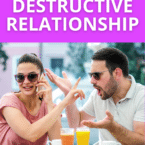
Addressing the lurking shadows in our lives can be tough but necessary. Destructive relationships – a dark reality for many – is one such shadow that needs our attention.
- Defining a Destructive Relationship
- Purpose of the Article
- The Importance of Awareness: A Case Example
- A. Understanding Destructive Relationships
- B. Impacts on Personal Life
- C. Impact on Professional Life
- D. Case Study: The Story of James
- E. The Broader Implication
- A. Overt Signs of Destructive Relationships
- B. Subtle Signs of Destructive Relationships
- C. Case Studies: Examples of Destructive Patterns
- A. The Tension Building Phase
- B. The Acute Incident Phase
- C. The Reconciliation Phase
- D. The Calm Phase
- E. Case Study: Sarah and Alex
- A. Power and Control
- B. Low Self-Esteem and Insecurity
- C. Cycle of Abuse
- D. Fear and Dependency
- E. Case Study: The Story of Megan and Ben
- A. Acknowledge the Problem
- B. Seek Professional Help
- C. Establish Boundaries
- D. Safety Planning
- E. Taking Legal Action
- F. Self-Care and Healing
- G. Case Study: Amy's Journey Out
- A. Hotlines
- B. Websites and Online Platforms
- C. Apps for Safety and Well-being
- D. Books
- E. Local Resources
Defining a Destructive Relationship
A destructive relationship is one characterized by harmful behaviors, manipulation, and control. Instead of mutual respect, love, and growth, such a relationship is dominated by patterns that erode one’s self-esteem and happiness.
Purpose of the Article
The purpose of this article is to shed light on these destructive patterns, help you identify if you’re in such a relationship, and provide effective strategies to navigate out of it. We’ll explore this through a balanced mix of clear signs, insightful case studies, and solutions.
The Importance of Awareness: A Case Example
Consider Jane, who was in a relationship with Tom. Jane often felt criticized and controlled by Tom, but she dismissed these as minor issues. Only when their relationship ended did Jane realize how deeply destructive these patterns had been, negatively impacting her self-esteem and mental health. Jane’s story underscores the need for awareness about destructive relationships, emphasizing the importance of understanding their signs and impacts early on.
II. The Nature and Impact of Destructive Relationships
Relationships should be sources of comfort, joy, and growth. But what happens when they turn harmful? Let’s delve into the nature and impacts of destructive relationships.
A. Understanding Destructive Relationships
Destructive relationships are not defined by a single fight or a rough patch. Instead, they are:
- Marked by a pattern of consistent harmful behaviors.
- Likely to cause emotional, psychological, or physical harm.
- Subtly damaging, often creeping into your life like weeds in a garden.
B. Impacts on Personal Life
The effects of a destructive relationship seep into various aspects of personal life. This includes:
- Mental Health Issues: Depression, anxiety, and post-traumatic stress disorder are common among people in destructive relationships.
- Physical Health Problems: Constant stress can lead to physical ailments, including heart disease and other stress-related disorders.
C. Impact on Professional Life
A destructive relationship doesn’t just stay at home. It follows you everywhere, impacting your professional life:
- Decreased Productivity: The stress and emotional turmoil can negatively impact concentration and productivity at work.
- Career Stagnation: Loss of interest and motivation can lead to missed opportunities and hinder career growth.
D. Case Study: The Story of James
James, a successful engineer, is a classic example of how destructive relationships can impact personal and professional lives:
- James’ partner, Lisa, consistently criticized and humiliated him and displayed controlling behavior.
- Over time, James’ productivity at work suffered, he lost interest in his job and passion projects, and his physical health declined due to stress and lack of sleep.
E. The Broader Implication
The impacts of destructive relationships ripple out, touching more than just the involved individuals. They affect family dynamics, friendships, and can even influence community wellbeing. Recognizing these patterns is the first step toward addressing this societal issue. As we move forward, we’ll equip you with the tools to identify and navigate these harmful relationship patterns.
III. Identifying Destructive Relationship Patterns
Being able to recognize the signs of a destructive relationship is the first step towards addressing it. Let’s explore these signs, from the overt to the subtly damaging.
A. Overt Signs of Destructive Relationships
Some harmful behaviors in a relationship are blatantly abusive. These include:
- Emotional Abuse: This might be constant belittling, criticizing, or insulting. You might be made to feel guilty or responsible for your partner’s actions.
- Physical Abuse: Any form of physical violence, no matter how minor it may seem, is a major red flag.
- Controlling Behaviors: This could involve controlling your activities, friendships, finances, or even your personal choices, like what to wear or eat.
B. Subtle Signs of Destructive Relationships
Other destructive behaviors are less obvious, often masquerading as care or concern. They include:
- Isolation: Your partner might start discouraging you from seeing friends or family or participating in activities you enjoy.
- Manipulation: They may twist facts, deny obvious truths, or make you question your perception, a tactic known as gaslighting.
- Constant Unease: You might feel like you’re always walking on eggshells, scared of your partner’s reaction or of starting an argument.
- One-sided Sacrifice: If the relationship always involves you making sacrifices or compromises, it might be a sign of a destructive relationship.
C. Case Studies: Examples of Destructive Patterns
Let’s consider a few real-life scenarios:
- Scenario 1: Mike constantly criticizes Kelly’s appearance and work, making her feel worthless. This is emotional abuse.
- Scenario 2: Brenda finds herself regularly canceling plans with friends because Tim doesn’t approve. This is a sign of controlling behavior leading to isolation.
- Scenario 3: Ryan always bends backward to accommodate Amanda’s preferences and demands, often neglecting his own needs. This represents a one-sided sacrifice.
Understanding these signs is crucial to recognizing if you’re in a destructive relationship. Next, we’ll delve into the typical cycle of such relationships and then the psychology behind them.

IV. The Cycle of a Destructive Relationship
Destructive relationships often follow a predictable cycle. Understanding this cycle can help in recognizing and breaking free from harmful patterns.
A. The Tension Building Phase
The first stage is characterized by growing tension and strain. Key signs include:
- Increased Conflict: Disagreements and arguments become more frequent.
- Walking on Eggshells: You might feel constant unease, fearing an explosive reaction from your partner.
- Communication Breakdown: Open and respectful dialogue deteriorates into criticism and blame.
B. The Acute Incident Phase
The tension culminates in a major incident, which may involve:
- Verbal or Emotional Abuse: This could be shouting, name-calling, insulting, or humiliating behavior.
- Physical Violence: In extreme cases, the conflict may escalate into physical aggression.
- Manipulation: The abuser might use manipulative tactics like gaslighting or emotional blackmail.
C. The Reconciliation Phase
After the acute incident, the abusive partner often tries to mend fences:
- Apologies and Promises: The abuser may apologize profusely, promising to change and that such an incident won’t happen again.
- Romantic Gestures: They might use affection, gifts, or attention to win back your trust.
- Minimization or Denial: They may also downplay the incident, insist it wasn’t that serious, or deny it outright.
D. The Calm Phase
A period of calm follows, giving an illusion of normalcy:
- Temporary Peace: There’s a noticeable reduction in tension and conflict.
- False Hope: You might believe that the abuser has genuinely changed.
- Cycle Reset: However, over time, the tension starts building again, and the cycle continues.
E. Case Study: Sarah and Alex
Consider Sarah and Alex’s relationship. Alex would often snap at Sarah over minor issues, building tension (Phase A). One day, he exploded, berating Sarah for her cooking (Phase B). Later, Alex apologized profusely and gifted Sarah a fancy necklace, promising he’d never lose his temper again (Phase C). There was peace for a while, but soon, the tension began building once more (Phase D).
Recognizing this cycle can empower you to seek help and break free from a destructive relationship. In the next sections, we’ll discuss the psychology behind destructive relationships and provide some effective strategies to handle such relationships.
V. Unpacking the Psychology Behind Destructive Relationships
To effectively handle destructive relationships, it’s important to understand the psychological mechanisms at play. Let’s unpack the common factors and dynamics.
A. Power and Control
At the heart of many destructive relationships is a power imbalance. This may manifest as:
- Domination: One partner exerting dominance over the other through emotional, physical, or financial control.
- Manipulation: Using tactics such as gaslighting, guilt-tripping, or blame-shifting to maintain control.
B. Low Self-Esteem and Insecurity
Often, destructive relationships stem from the insecurities and low self-esteem of the abuser:
- Criticism and Humiliation: The abuser may belittle the victim to feel better about themselves.
- Jealousy and Possessiveness: Insecurity can lead to extreme jealousy and possessive behavior, seen as attempts to control the victim.
C. Cycle of Abuse
Abuse is often a cycle passed down through generations:
- Learned Behavior: If a person grew up witnessing abuse, they may unconsciously replicate the same patterns in their relationships.
- Normalization of Violence: Growing up in an abusive environment can also lead to the normalization of violence and toxic behavior.
D. Fear and Dependency
The victim may stay in the destructive relationship due to fear or dependency:
- Fear of Retaliation: The victim might fear the abuser’s reaction if they attempt to leave or confront them.
- Emotional or Financial Dependency: The victim may feel emotionally attached to the abuser or depend on them financially, making it difficult to leave.
E. Case Study: The Story of Megan and Ben
Megan, despite being constantly criticized and controlled by Ben, found it hard to leave. She had become emotionally dependent on Ben (D.2) and also feared his anger if she tried to confront him (D.1). On the other hand, Ben, who grew up with a domineering father, was replicating the same behaviors in his relationship (C.1), using power and control (A.1) to compensate for his deep-seated insecurities (B.2).
In the next section, we’ll explore the ways to deal with destructive relationships, empowering you to take positive steps towards change.

VI. Breaking Away: Steps to Navigate out of a Destructive Relationship
Knowing the signs and understanding the psychology behind destructive relationships are vital steps. The next big step is navigating your way out. Let’s explore some of the actions you can take.
A. Acknowledge the Problem
The first step is to recognize and admit that you’re in a destructive relationship. This might involve:
- Acceptance: Coming to terms with the reality of the situation, even if it’s painful.
- Stop Rationalizing: Ceasing to justify your partner’s harmful behaviors.
B. Seek Professional Help
Therapists, counselors, and support groups can provide invaluable help:
- Individual Therapy: A therapist can help you understand your feelings, cope with trauma, and plan your next steps.
- Support Groups: Sharing experiences with others who’ve faced similar situations can provide comfort and practical advice.
C. Establish Boundaries
Creating and maintaining boundaries is critical:
- Physical and Emotional Boundaries: This may include rules about personal space, respect, communication, and conflicts.
- Stick to Your Boundaries: Even if the abusive partner resists, it’s crucial to uphold your boundaries.
D. Safety Planning
If the relationship involves physical abuse, it’s vital to have a safety plan:
- Emergency Contacts: Keep a list of emergency numbers (friends, family, local police).
- Escape Plan: Plan how to safely leave the house in an emergency, including where to go and what to bring.
E. Taking Legal Action
In severe cases, you may need to take legal action:
- Restraining Orders: Consider getting a restraining order if you fear for your safety.
- Legal Advice: Consult with a lawyer to understand your rights and options.
F. Self-Care and Healing
Taking care of your physical and mental health during this time is crucial:
- Physical Health: Regular exercise, a healthy diet, and adequate sleep can help you cope better with stress.
- Mental Health: Mindfulness practices, hobbies, and relaxation techniques can aid in mental healing.
G. Case Study: Amy’s Journey Out
Amy was in a destructive relationship with Sam. Recognizing the problem, she sought help from a therapist (B.1) and joined a support group (B.2). She established boundaries with Sam (C.1), but when he violated them, she decided to leave. With a safety plan in place (D.2), Amy successfully broke free. She then focused on self-care, rediscovering her love for painting, and practicing mindfulness, which helped her heal (F.2).
Navigating out of a destructive relationship is challenging, but remember, you’re not alone. Reach out, seek help, and take one step at a time towards a healthier, happier life.
VII. Helpful Resources
If you’re navigating a destructive relationship, there are various resources available to assist you. Here are some you might find helpful:
A. Hotlines
- National Domestic Violence Hotline: Reach out at 1-800-799-SAFE (7233) for immediate help. You can also visit [thehotline.org](https://www.thehotline.org/) for more information.
- Crisis Text Line: If you’re uncomfortable with a phone call, you can text HOME to 741741 to communicate with a trained crisis counselor.
B. Websites and Online Platforms
- Love is Respect: This organization offers resources on healthy and unhealthy relationships. Visit for articles, quizzes, and chat support.
- Psychology Today Therapist Directory: Find a therapist near you using this online directory.
C. Apps for Safety and Well-being
- Aspire News App: This app includes a “Go Button” that alerts your trusted contacts when you’re in danger.
- Moodfit: An app designed to improve mental health, offering tools for mindfulness, cognitive behavioral therapy, and more.
D. Books
- “The Emotionally Abusive Relationship” by Beverly Engel: This book offers insights into recognizing and overcoming emotional abuse.
- “Why Does He Do That?” by Lundy Bancroft: This book helps readers understand the mindset of abusive partners.
E. Local Resources
- Local Shelters: Look up shelters in your area where you can seek temporary refuge if necessary.
- Local Support Groups: Many cities have support groups for individuals in destructive relationships. Search online or ask a healthcare professional for recommendations.
Remember, no one deserves to be in a destructive relationship. There’s always help available; reach out when you’re ready.
Final Thoughts
Navigating destructive relationships can be incredibly challenging. However, by learning to recognize the signs and understand the underlying psychology, you empower yourself to break free from harmful patterns and seek a healthier path forward.
Remember, acknowledging the problem is the first step. From there, leaning on professional support, establishing boundaries, ensuring safety, and practicing self-care are key to your journey out of a destructive relationship. Always know that you are not alone in this fight, and a multitude of resources exist to help you.
Don’t hesitate to reach out for support when you’re ready. By taking these steps, you’re affirming your right to a relationship that brings you joy, respect, and mutual growth. No matter how difficult things may seem, change is possible, and a better, healthier relationship awaits you.
















